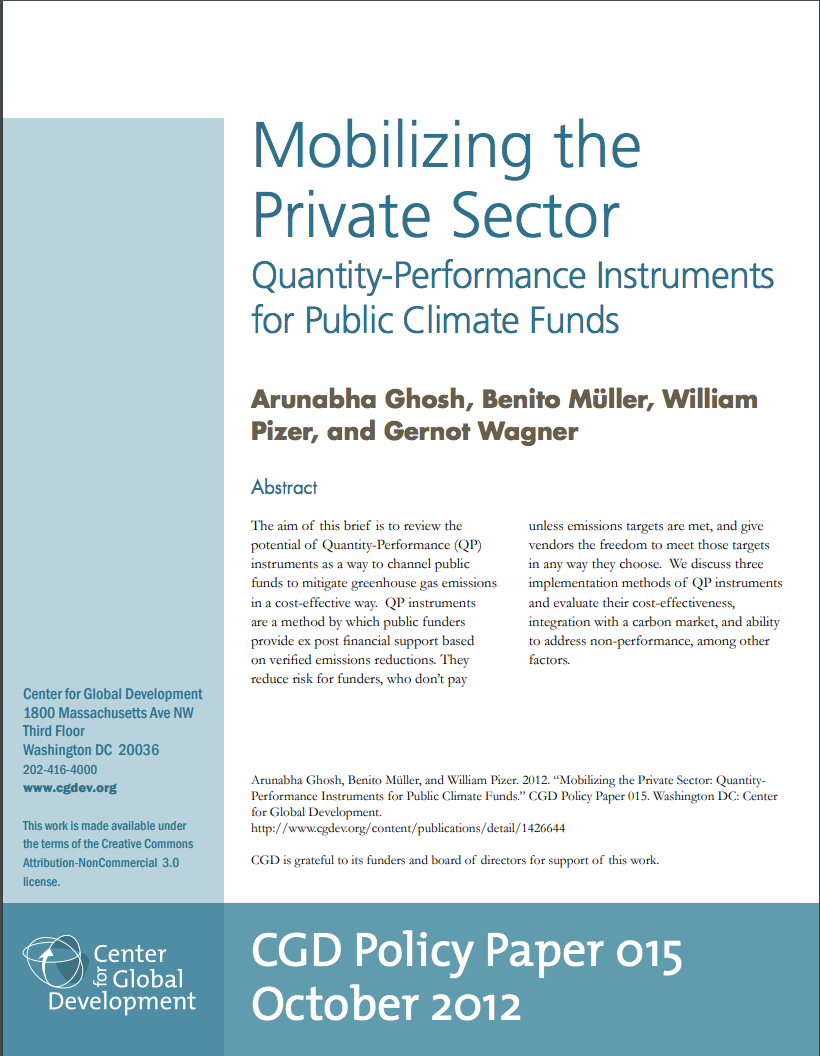Paper
Mobilising the Private Sector
Quantity-Performance Instruments for Public Climate Funds
Arunabha Ghosh, Benito Müller, William Pizer, Gernot Wagner
October 2012 |
Suggested citation: Ghosh, Arunabha, Benito Müller, William Pizer, and Gernot Wagner. 2012. “Mobilizing the Private Sector: Quantity-Performance Instruments for Public Climate Funds,” Oxford Energy and Environment Brief, The Oxford Institute for Energy Studies, pp. 1-15.
Overview
This paper reviews options for the use of Quantity-Performance (QP) instruments as a way of channeling public funds to mitigate greenhouse gas emissions in a cost-effective way. QP instruments reward quantified mitigation performance, typically measured in tonnes of CO2-equivalent of achieved emissions reductions. The paper focuses on activities associated with QP indicators, including performance assessed in terms of measured quantities such as tonnes (of carbon), kWh, or hectares as carried out by the private sector. It recommends that QP can be used by governments or multilateral funds such as Green Climate Funds to mobilise the private sector and private sector finance for mitigation activities in developing countries.
Key Highlights
- QP instruments have the potential for cost-effective allocations of public funds, providing incentives for eligible recipients of public sector funds to supply as much (quantity) verified reduction as possible.
- Public investment could remove barriers where QP-based instruments are not (currently) feasible through capacity building and institutional development.
- Funding could be provided on a first-come, first-served basis until the resources are expended as implemented in the Clean Technology Fund and proposed for the Prototype Methane Financing Facility (PMFF).
- QP instruments can be designed so that public sector funds become the catalyst for reductions ultimately delivered into a market, if and when an emission market is ready.
- All QP instruments have the potential to be cost-effective, in terms of providing the maximum amount of verified emissions reductions for a given amount of public funds, if they are allocated through a competitive auction mechanism.
- Three QP Variations have featured prominently in climate finance debates and each itself having a number of variants.
- Direct Purchase: direct purchase of verified reductions by the funder who would offer to buy reductions at a specified price with a given pool of public funds.
- Top-up instrument: obliges the funder to pay the vendor the difference between an agreed price and the prevailing carbon market price when the credits are delivered to the market. The top-up instrument both ensures that the contracted reductions eventually enter that market, and links the top-up payment to the price received by the vendor.
- Tradable put options: funder creates tradable option contracts for vendors. The contract provides the vendor with the right to sell to the funder a certain amount of reductions at a certain agreed price by a certain time.
- Direct purchase and top-up instruments can address non-performance through more stringent participation criteria, bonding, or penalties for non-performance.
Key Recommendations
- Use QP instruments to maximise achievable emissions reductions within the scope of eligible activities and using public funding in question.
- Recognize that the drive for cost-effectiveness may lead to a ‘regional’ concentration of the funding flows, as it happened in the case of the CDM.
- Allocate the overall funds into geographical windows based on political criteria to achieve a desired geographic balance, then proceed to use QP instruments within each funding window.
- Keep a single ‘global’ QP window, and deal with the imbalances through other non-QP funding windows.
- Address the central issues of balancing cost-effectiveness, allocation, and adequacy of supply as done by new public funding sources such as the Green Climate Fund.
When coupled with a competitive allocation, QP instruments can maximize achievable emissions reductions within the scope of eligible activities and using public funding in question.





